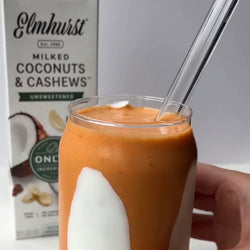What Is Nut Milk? A Lactose-Free Milk Alternative


Nut milk is obviously milk made from nuts: almonds, walnuts, cashews, hazelnuts, and more. Now back to our regular scheduled programming. Hope you enjoyed reading.
Just kidding – we're still here! While it sounds simple, nut milk becomes interesting when we zoom out and compare it to something; something far older, so old that we cannot fathom a time that it was new. This would be dairy milk, nut milk's predecessor and natural rival.
Nut milk is winning. Since the almond explosion during the 2010s, the category has steadily grown while consumption of dairy continues to decline. 1 As you will learn, there are many reasons for people to exchange dairy products for nut milks, presumably the greatest being its use as a legitimate lactose-free milk alternative.
Is Dairy Bad for You?
Elmhurst certainly didn't think so over 90 years of operation as a dairy. What started as a small operation on a family farm in Queens grew to become New York City's last standing dairy. Nearby farms and processors, of which there were more than 20, maximized profit from prime real estate. Others simply couldn't endure the dip in fluid milk consumption, which has been in swing since the 1970s. Consumption took its sharpest turn in 2015, wherein sales dropped by 7% compared to the previous year. 2 Indeed, Elmhurst was barely surviving when it decided to close its doors in 2016.
People weren’t distancing themselves from dairy because it wasn't cool anymore; rather, it had been convicted by health and environmental concerns:
Dairy health concerns:
- Induction of leaky gut: Dairy contains molecules that inhibit our bodies’ digestive enzymes, preventing the full degradation of proteins in our food. Incompletely digested proteins can transit our intestinal barrier and enter our bloodstream, stimulating the immune system to mount an antibody attack that results in increased intestinal inflammation. 3
- Presence of allergenic proteins: Casein and whey, allergenic proteins in cow’s milk, can often be mistaken by our immune system as gluten, causing digestive distress in individuals with gluten sensitivity or Celiac disease. 4
- Intolerance to lactose: For the majority of the population, production of the enzyme lactase decreases after weaning. When undigested lactose arrives in the colon, gut bacteria feed on it, leading to the production of excessive gas, bloating, and diarrhea. It is estimated that worldwide, more than two-thirds of all adults are lactose intolerant! 5
Dairy environmental concerns:
- Each serving of dairy you consume represents 0.72 lbs carbon dioxide equivalent (CO2e; compare with 0.16 for rice; 0.11 for peanuts). 6
- Livestock and manure accounted for 3.3% of total US greenhouse gas emissions in 2012 – 40% of agriculture's carbon footprint. 6
- In an average non-vegetarian diet, animal products account for 80% of the total carbon footprint from greenhouse gas emissions. 6
As these revelations unfolded, nut milk’s popularity exploded. The almond milk boom hit in 2013, soon displacing soy as the darling of plant-based milks. Boosted by this and other nut milk varieties, the global dairy alternative market topped $16 billion in 2018, up from $7.4 billion in 2010. 7
All of this writing was on Elmhurst's wall in 2016. However, in shuttering the Queens plant, owner Henry Schwartz only closed one era of Elmhurst. Nutrition was changing. His company changed with it, reemerging on the outskirts of Buffalo in 2017 with what began as a line of milks made from nuts, and has since expanded to include oats, unsweetened, barista, and seeds – all firmly entrenched in plant-based alternatives. This is today's Elmhurst 1925.
By choosing the right nut-based milk, you can reinvent your diet, much as Henry reinvented his company. A catalog of unique tastes – supported by health and sustainability – offers an escape from the mundanity and negative side effects experienced from dairy.

Do Nut Milks Work as Dairy Alternatives?
Absolutely. Fads come and go, but the real deal lasts. Rewinding to past centuries, and extending our view to far-off places reveals that plant-based milk was a "thing" before our dairy ever took center stage. There is evidence of soy milk in China from 1365. Rice milk has been consumed in Latin America as horchata since the 8th century. The 13th century witnessed almond milk in the Middle East, India, and North Africa – with the drink first making an appearance in a Baghdad cookbook. All of these examples, woven into the rich cultural fabric of history, illustrate both nut milk's applicability and indispensability across so many traditional cuisines. 8
This also suggests optionality. A global world brings the unique tastes of different places to our grocery stores; and, of course, the Internet. Current plant-based possibilities include:
- Almond milk
- Walnut milk
- Cashew milk
- Hazelnut milk
- Oat milk
- Rice milk
- Peanut milk
- Coconut milk
- Hemp milk
- Pistachio milk
Each of these plant-based milks has a distinct nutritional profile based on its source ingredient. However, even within a given type (i.e. almond milk), there may be significant variation across brands. This disparity becomes more pronounced when the quantity of the star ingredient is called into question. Many players in the nut milk field are little more than water emulsions, sprinkled with a few nuts, and thickened with added gums and emulsifiers. These are barely nut milks, let alone dairy alternatives! Made with up to 4x as many nuts per serving, Elmhurst's range of options achieves a natural milk-like creaminess with nutritional quality to match.
Versatility is a common thread linking all Elmhurst nut milks:
- Almond milk (unsweetened) is great for cereal and smoothies.
- Hazelnut milk (unsweetened) works well in cereal, smoothies, iced coffee, and baking.
- Cashew milk: (original and unsweetened) functions in coffee, soups, sauces, baking, cereal, and smoothies.
- Walnut milk: (unsweetened) enhances smoothies, iced coffee, cereal, and baking.
Having diverse uses, many of which beautifully emulate dairy, means more recipes: baking recipes, smoothie recipes, cooking recipes, etc. Additionally, specially designed barista plant milks and creamers make lush coffee concoctions possible.

Health Benefits of Nuts
The main reason to drink nut milk is, of course, for the nuts themselves. Nuts are a rich source of macronutrients and micronutrients, including:
- Omega-3 fatty acids
- Vitamin E
- Manganese
- Magnesium
- Riboflavin (Vitamin B2)
- Selenium
- Copper
- Thiamine
Collectively, these nutrients perform very important functions, particularly fighting free radicals which cause cellular damage in the body, and aiding energy production. 9
Reputable studies illuminate some other important reasons to consume nuts. Here we provide just a few of many examples.
- Nuts may aid weight loss.
- Eating almonds every day for 6 weeks decreased cholesterol levels and abdominal fat 10
- Nuts may improve blood sugar and blood lipids.
- Eating pistachios helped maintain normal blood sugar after eating a high carb meal 11
- Increasing almond intake can help improve insulin sensitivity and lower cholesterol in adults with prediabetes 12
- A single serving of Brazil nuts was found to significantly lower LDL cholesterol and raise HDL cholesterol within just nine hours 13
- A diet high in hazelnuts reduced total cholesterol by nearly 8% and triglycerides by 7%, and increased HDL by 6% 14
- A diet rich in macadamia nuts helped reduce both total and bad LDL cholesterol in 25 adults with high cholesterol 15
- Nuts may reduce inflammation.
- Consumption of macadamia nuts over 4 weeks helped reduce markers of oxidative stress and inflammation in 17 patients 16
- Nuts may reduce risk of heart attack and stroke.
Why Try Elmhurst Nut Milk?
The nut milk sea has filled quickly. Some are more colorful than others – but beware! A flashy appearance, or elegantly curved bottle, may disguise a fundamental void of substance.
Dairy has problems, but it also has nutrients. Every package with "almond milk" written across its panel doesn't automatically qualify as a legitimate lactose-free dairy alternative. It has to have the nuts first. When you reference an almond milk nutrition panel and see 1g of protein, this is NOT a true dairy alternative. Almonds have protein. By extension, the competitive product you are looking at is likely not made with many nuts at all!
One example of the broader promise of our plant-based options, Elmhurst Unsweetened Milked Almonds™, has two ingredients, 5g protein per serving, and is made with up to 4x as many nuts as other leading brands. If you are looking to augment your omega-3 intake, opt for Elmhurst’s unsweetened walnut milk, which offers 1400mg ALA omega-3s in a single cup.
Nutrition, sustainability, taste – these are all reasons to swap dairy, like Elmhurst did, and try something new!
References
- Franklin-Wells O. White gold: the unstoppable rise of alternative milks Health & Fitness 2019; https://www.theguardian.com/news/2019/jan/29/white-gold-the-unstoppable-rise-of-alternative-milks-oat-soy-rice-coconut-plant. Accessed June 25, 2019, 2019.
- Rowland MP. Got Milk? A Tale Of Two Cities. 2017; https://www.forbes.com/sites/michaelpellmanrowland/2017/04/11/milk-industry-controversy/#484c13f357e5. Accessed June 20, 2019, 2019.
- Stewart AS, Pratt-Phillips S, Gonzalez LM. Alterations in Intestinal Permeability: The Role of the "Leaky Gut" in Health and Disease. Journal of equine veterinary science. 2017;52:10-22.
- Solinas C, Corpino M, Maccioni R, Pelosi U. Cow's milk protein allergy. The journal of maternal-fetal & neonatal medicine : the official journal of the European Association of Perinatal Medicine, the Federation of Asia and Oceania Perinatal Societies, the International Society of Perinatal Obstet. 2010;23 Suppl 3:76-79.
- Mattar R, de Campos Mazo DF, Carrilho FJ. Lactose intolerance: diagnosis, genetic, and clinical factors. Clinical and experimental gastroenterology. 2012;5:113-121.
- Systems CfS. Carbon Footprint Factsheet. 2018; http://css.umich.edu/factsheets/carbon-footprint-factsheet. Accessed June 20, 2019, 2019
- Insights IM. Global Plant Milk Market to Top US $16 Billion in 2018: Dairy Alternative Drinks Are Booming, Says Innova Market Insights. 2017; https://www.prnewswire.com/news-releases/global-plant-milk-market-to-top-us-16-billion-in-2018--dairy-alternative-drinks-are-booming-says-innova-market-insights-300472693.html. Accessed June 20, 2019, 2019.
- Powell V. A Brief History of Plant Milks. 2019; https://www.vivahealth.org.uk/healthfeatures/brief-history-plant-milks. Accessed June 20, 2019, 2019.
- de Souza RGM, Schincaglia RM, Pimentel GD, Mota JF. Nuts and Human Health Outcomes: A Systematic Review. Nutrients. 2017;9(12).
- Berryman CE, West SG, Fleming JA, Bordi PL, Kris-Etherton PM. Effects of daily almond consumption on cardiometabolic risk and abdominal adiposity in healthy adults with elevated LDL-cholesterol: a randomized controlled trial. Journal of the American Heart Association. 2015;4(1):e000993.
- Kendall CW, Josse AR, Esfahani A, Jenkins DJ. The impact of pistachio intake alone or in combination with high-carbohydrate foods on post-prandial glycemia. European journal of clinical nutrition. 2011;65(6):696-702.
- Wien M, Bleich D, Raghuwanshi M, et al. Almond consumption and cardiovascular risk factors in adults with prediabetes. Journal of the American College of Nutrition. 2010;29(3):189-197.
- Colpo E, Vilanova CD, Brenner Reetz LG, et al. A single consumption of high amounts of the Brazil nuts improves lipid profile of healthy volunteers. Journal of nutrition and metabolism. 2013;2013:653185.
- Orem A, Yucesan FB, Orem C, et al. Hazelnut-enriched diet improves cardiovascular risk biomarkers beyond a lipid-lowering effect in hypercholesterolemic subjects. Journal of clinical lipidology. 2013;7(2):123-131.
- Griel AE, Cao Y, Bagshaw DD, Cifelli AM, Holub B, Kris-Etherton PM. A macadamia nut-rich diet reduces total and LDL-cholesterol in mildly hypercholesterolemic men and women. The Journal of nutrition. 2008;138(4):761-767.
- Garg ML, Blake RJ, Wills RB, Clayton EH. Macadamia nut consumption modulates favourably risk factors for coronary artery disease in hypercholesterolemic subjects. Lipids. 2007;42(6):583-587.
- Banel DK, Hu FB. Effects of walnut consumption on blood lipids and other cardiovascular risk factors: a meta-analysis and systematic review. The American journal of clinical nutrition. 2009;90(1):56-63.
- Ma Y, Njike VY, Millet J, et al. Effects of walnut consumption on endothelial function in type 2 diabetic subjects: a randomized controlled crossover trial. Diabetes care. 2010;33(2):227-232.
- Kasliwal RR, Bansal M, Mehrotra R, Yeptho KP, Trehan N. Effect of pistachio nut consumption on endothelial function and arterial stiffness. Nutrition (Burbank, Los Angeles County, Calif). 2015;31(5):678-685.



